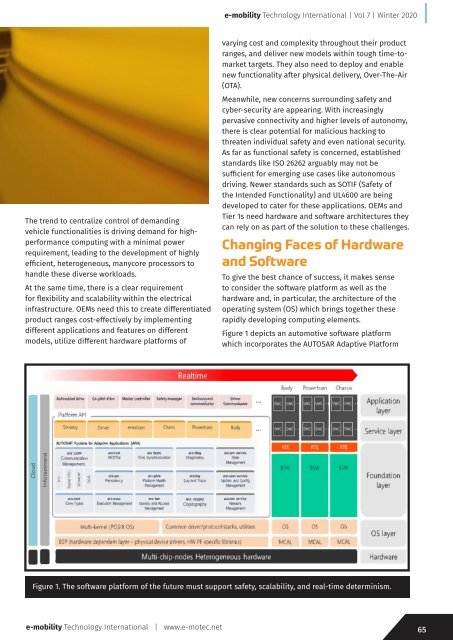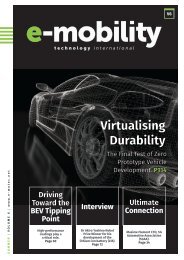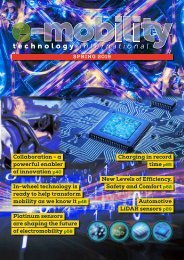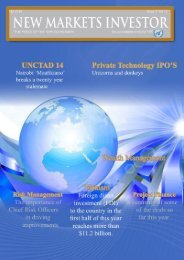E-mobility Technology Winter 2020
Electric vehicle technology news: Maintaining the flow of information for the e-mobility technology sector
Electric vehicle technology news: Maintaining the flow of information for the e-mobility technology sector
Create successful ePaper yourself
Turn your PDF publications into a flip-book with our unique Google optimized e-Paper software.
e-<strong>mobility</strong> <strong>Technology</strong> International | Vol 7 | <strong>Winter</strong> <strong>2020</strong><br />
The trend to centralize control of demanding<br />
vehicle functionalities is driving demand for highperformance<br />
computing with a minimal power<br />
requirement, leading to the development of highly<br />
efficient, heterogeneous, manycore processors to<br />
handle these diverse workloads.<br />
At the same time, there is a clear requirement<br />
for flexibility and scalability within the electrical<br />
infrastructure. OEMs need this to create differentiated<br />
product ranges cost-effectively by implementing<br />
different applications and features on different<br />
models, utilize different hardware platforms of<br />
varying cost and complexity throughout their product<br />
ranges, and deliver new models within tough time-tomarket<br />
targets. They also need to deploy and enable<br />
new functionality after physical delivery, Over-The-Air<br />
(OTA).<br />
Meanwhile, new concerns surrounding safety and<br />
cyber-security are appearing. With increasingly<br />
pervasive connectivity and higher levels of autonomy,<br />
there is clear potential for malicious hacking to<br />
threaten individual safety and even national security.<br />
As far as functional safety is concerned, established<br />
standards like ISO 26262 arguably may not be<br />
sufficient for emerging use cases like autonomous<br />
driving. Newer standards such as SOTIF (Safety of<br />
the Intended Functionality) and UL4600 are being<br />
developed to cater for these applications. OEMs and<br />
Tier 1s need hardware and software architectures they<br />
can rely on as part of the solution to these challenges.<br />
Changing Faces of Hardware<br />
and Software<br />
To give the best chance of success, it makes sense<br />
to consider the software platform as well as the<br />
hardware and, in particular, the architecture of the<br />
operating system (OS) which brings together these<br />
rapidly developing computing elements.<br />
Figure 1 depicts an automotive software platform<br />
which incorporates the AUTOSAR Adaptive Platform<br />
Figure 1. The software platform of the future must support safety, scalability, and real-time determinism.<br />
e-<strong>mobility</strong> <strong>Technology</strong> International | www.e-motec.net<br />
65









